ARCHITECTURAL PROJECTS
PUBLIC
17 June, 2010
WORLD CUP FIFA 2010
The FIFA world cup 2010 is now a fact. Ten stadiums that will host the organisation.
The FIFA world cup 2010 is now a fact and takes place in South Africa and specifically in the cities of Johannesburg, Cape town, Polokwane, Bloemfontein, Nelspruit,Pretoria and rustenbourg. The host Country has given to FIFA 10 magnificent stadiums where the crowd will enjoy the whole event.
Johannesburg:
Soccer City stadium
Architect: Urban Boogertman Edge
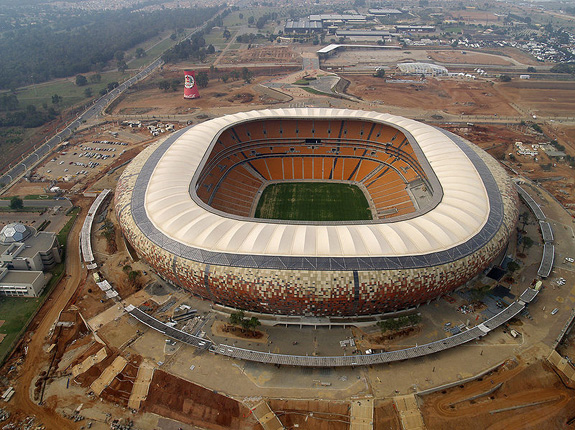
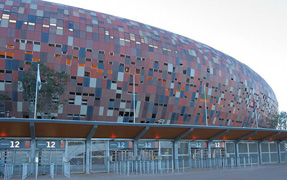
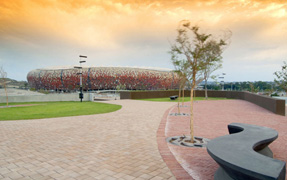
Over 90 000 fans will fill up this World Cup centerpiece to watch some of the most important matches in the 2010 FIFA World Cup(tm). Hosting both the opening match and the final, Soccer City stadium will soon become one of the world's most photographed structures and a world renowned symbol of South Africa's emergence onto the world stage.The original stadium built in 1987 with major renovations now being done. The only remaining section of the stadium is the West stand. The stadium resembles a Calabash which is an African cooking pot. It was decided that this would be the most recognizable image to represent the continent. The façade of the stadium (outer edge) is made up of fiber reinforced panels with a selection of 8 different colors. The façade has 10 vertical slots which are geographically aligned with the nine other 2010 FIFA World Cup stadiums as well as the Berlin stadium which hosted the final of the previous FIFA World Cup. This represents the road to the final.
info: http://www.architravel.com/architravel/building/740
Ellis park stadium
Architect: DBN architects
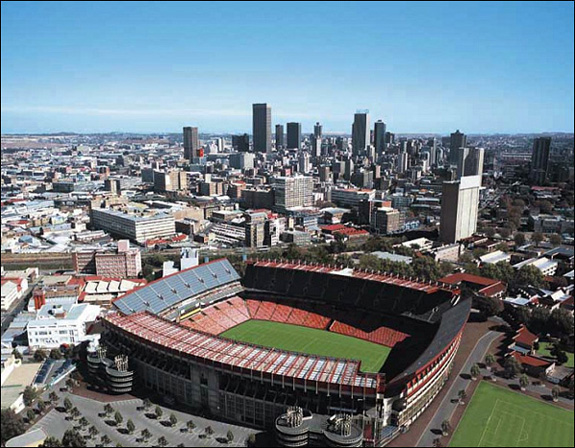
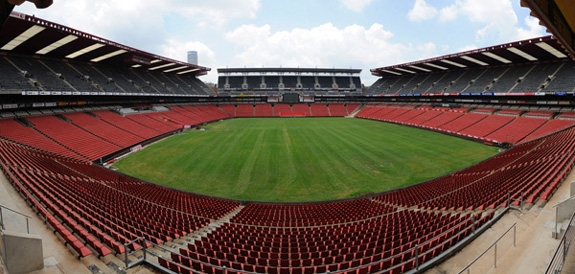
Located in the centre of Johannesburg, Ellis Park Stadium was first built in 1928 as a rugby union stadium. It was demolished and rebuilt in 1982 exclusively for rugby and its named after JD Ellis, a Johannesburg city concilor who approved the use of the land for the stadium. The stadium has hosted many sporting events including the final of the 2009 FIFA Confederations Cup. For the FIFA World Cup 2010 the Stadium's capacity will be increased by 5,000 seats on the northern side only, to 65,000. Areas like the Presidential suite are already receiving a facelift. There will also be a hospitality room and new changing rooms.
Unlike most other 2010 FIFA World Cup venues, it will likely be able to use its commercial name, Coca-Cola Park, during the World Cup. FIFA controls all naming rights associated with the World Cup, which means that stadiums generally cannot use commercial names during the competition; however, The Coca-Cola Company is a major FIFA sponsor.
Cape Town:
Green Point Stadium
Architects: Marg and Partners Architects, Louis Karol Architects, Point Architects
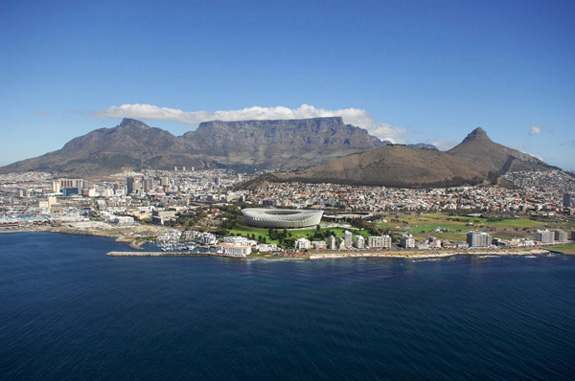
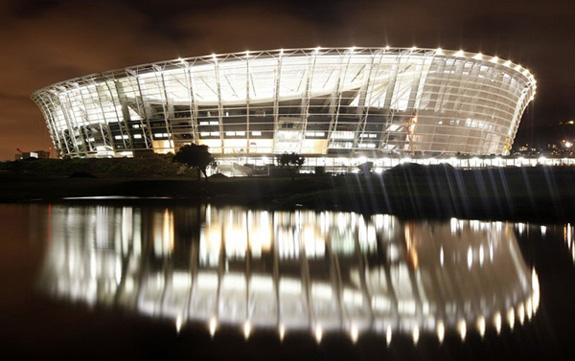
The Stadium is situated as a solitary body, embedded in Greenpoint Common at the foot of Signal Hill and is ordered respectfully into the landscaped complex. The exterior shell of the stadium was designed as an abstract, linearly arranged membrane construction. Its unique undulating silhouette, which is the result of the geometry of the stadium body, transforms it into a sculptural object and intensifies its integration into the existing landscape.
The light membrane is composed of expansive concave elements that form a cohesive flowing facade, which follows the stadium's undulating shape. The light-colored glass-fiber tissue emphasizes this effect, since its color creates a sense of depth and animation, and the translucent surface absorbs and reflects the effect of the existing daylight.
The roof construction is a combination of a suspended roof with radial truss structure. The undulating roof is outfitted with laminated safety glass elements and its interior is faced with a diaphanous membrane. Technical features are integrated into the space between the glass roofing and the membrane, such as acoustic and lighting systems. This space also provides protection from the weather and serves as a sound insulating volume.
Situated between the world famous Table Mountain, which dominates Cape Town's skyline and the blue waters of the Atlantic Ocean, Green Point stadium is a new icon of Cape Town born to sit alongside the city's already-famous landmarks.
info: http://www.architravel.com/architravel/building/738
Durban:
Moses Mabhida Stadium
Architect: Marg and Partners Architects
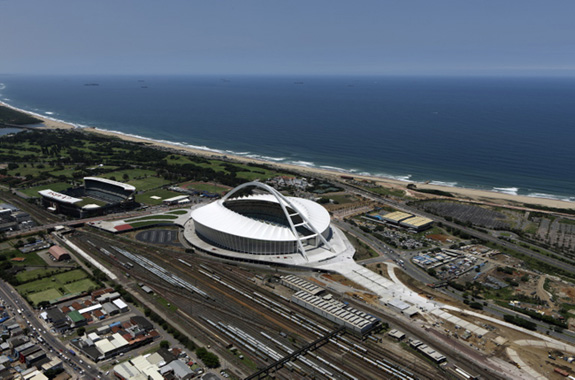
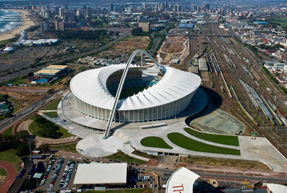
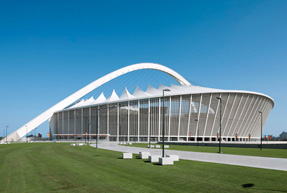
Situated on a raised platform, the multifunctional stadium is accessed from the south via a broad flight of steps. A 104m [two-pronged] arch curves high over the stadium as an emblem, visible far and wide. The main entrance at the end of a 2.5km linear park coincides with the bifurcation of the arch, as a gateway to the city.
A cable car at the northern end leads to the Skywalk at the apex of the arch. From here, visitors can enjoy a spectacular view over the city and the Indian Ocean. As a distinctive feature, the arch, gives the stadium its unique silhouette, while as a landmark it forms an imposing part of the skyline of Durban. The geometry of the roof is predetermined by the architectural concept. Between the strong compression ring of the stadium bowl and the arch, a series of radial cables are clamped on the inner edge of the roof so as to make the tension ring almond-shaped. The façade of open lamellae, which follows the undulations in the volume of the stadium, screens the encircling walkway from the sun and the frequent bouts of wind while permitting a free view outwards. The outer skin is in effect a geometrical overlay of a cone imposed on a cylinder, making a walk round the circuit of the stadium a interesting event, with the angle of the rising facades changing as you progress. The new stadium with its surrounding green areas for sports, leisure and cultural activities and social uses will develop into the focus of an attractive urban area and establish itself as a high-quality venue for sports events in South Africa.
info: http://www.architravel.com/architravel/building/739
Port Elizabeth:
Nelson Mandela Bay Stadium
Architect: Architectural Design Associates, Dominic Bonnesse Architects
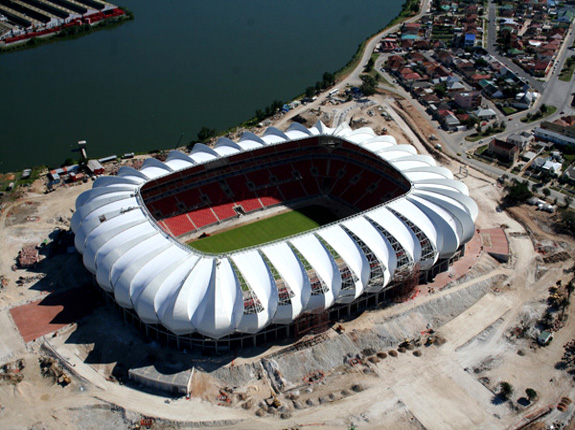
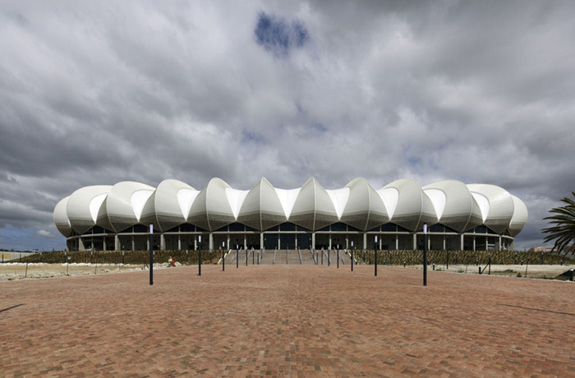
The stadium has an eye-catching, unique roof-structure and a spectacular view, overlooking the North End Lake. There are not many stadiums in the world that are designed and constructed overlooking a lake; this in itself is a very distinctive feature of the Nelson Mandela Bay Multi-Purpose Stadium, in addition to its striking design. The roof material of the stadium consists of a combination of aluminium cladding, combined with a membrane material called PTFE (polytetraflurethylene), which is a coated glass-fibre fabric and steel super structure. The total length of piles installed is 21 000m and the material excavated is 138 000m3 .
The stadium building is approximately 40m high and consists of six levels on the western side in addition to five on each of the north, south and east stands. All aspects of the project have factored in energy efficiency as a key element. These include energy-saving designs, the building management system, and temperature control and reduced energy consumption rates. The playing field (pitch) is natural grass with the outer and surrounding areas consisting of artificial turf.
info: http://www.architravel.com/architravel/building/742
Polokwane:
Peter Mokaba Stadium
Architect: Prism Architects
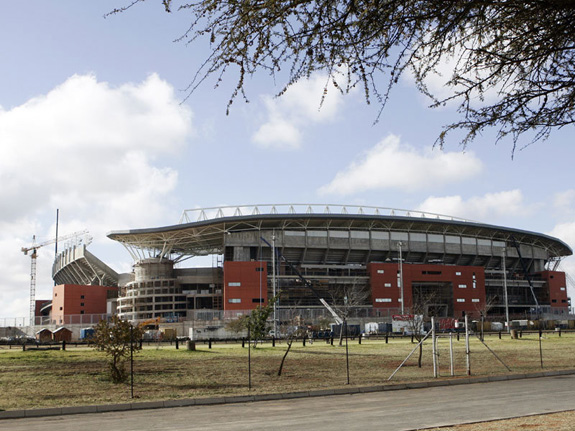
The original brief from the Client (Polokwane Municipality) was to investigate whether the existing old Peter Mokaba Stadium with its limited seat capacity could be expanded; to construct a new stadium on a new premises or alternatively construct a new stadium on the old Peter Mokaba Stadium, with the old facility having to be demolished. the final decision was that the existing Peter Mokaba Stadium with its athletic track would remain intact, while a new 45 000 seat FIFA compliant stadium would be built adjacent to the existing structure. Along this way a strong supporting sport node could be established to ensure Polokwane as the sporting Capital of the Limpopo Province.When the design started, the approach was what would make our stadium stand out amongst others, but at the same time would be unique and appropriate to the area, the "bushveld", where we live in. Hence, our decision straight away fell on the icon of the province, the Baobab tree, and this was simulated into the support structures of the roof. Furthermore, although everyone considered the "bushveld" to be flat, Polokwane is surrounded by some beautiful low range mountains and this with various earth coat colour schemes, depending on sun reflection angles, has all been taken care of into the seating configuration.
Rustenburg:
Royal Bafokeng stadium
Architect: BSP Architects
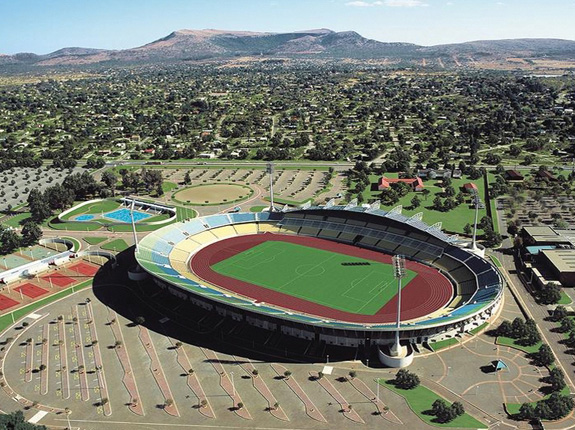
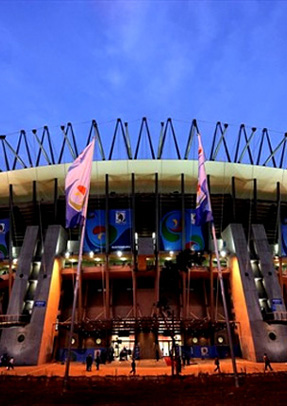
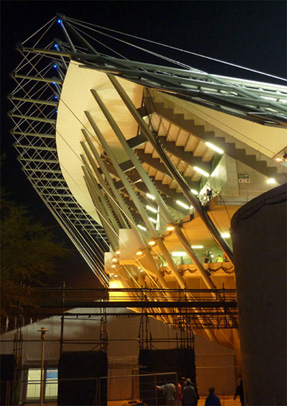
Reflecting natural features with its saddle shape, the Royal Bafokeng sporting premise is set to play an important role, becoming more of a soccer stadium. After rugby 1995 the stadium is set to embrace more of this legacy by being one of the ten stadiums to host the 2010 Fifa World Cup soccer tournament. During the 2010 Fifa World Cup matches the Bafokeng Plaza is scheduled to operate as a shopping complex but with strict conditions that comply with Fifa and the host city agreements. The management of the sporting premise remains under the municipality of Bafokeng people who have kept this stadium in very good fix.
info: http://www.architravel.com/architravel/building/768
Nelspruit:
Mbombela Stadium
Architect: RL Architects
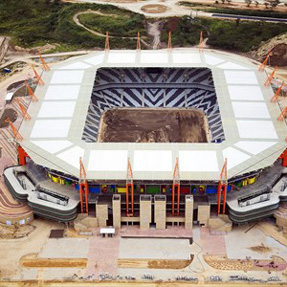
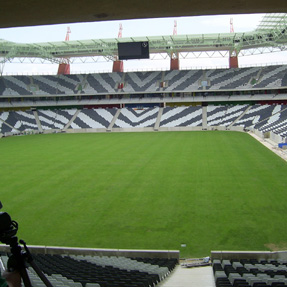
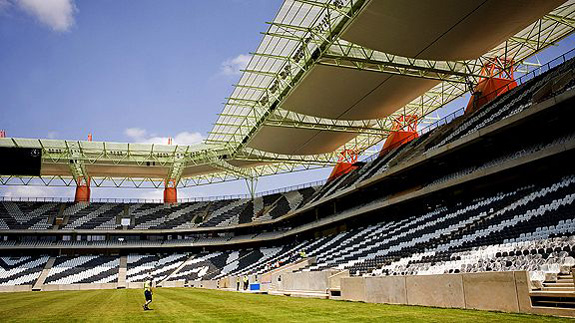
Faced with a tight and immovable delivery deadline, soaring materials prices and stiff competition for the services of skilled construction contractors, Mott MacDonald responded by designing a stadium roof that sets international standards for weight and cost efficiency, and that has been simple to build. At the same time, the roof - the visually dominant element of the stadium - is iconic and appropriate to the stadium's setting on the edge of world famous Kruger National Park: its structural masts are evocative of giraffes.
Pretoria:
Loftus Versfeld Stadium
Architect: Ingplan Africa
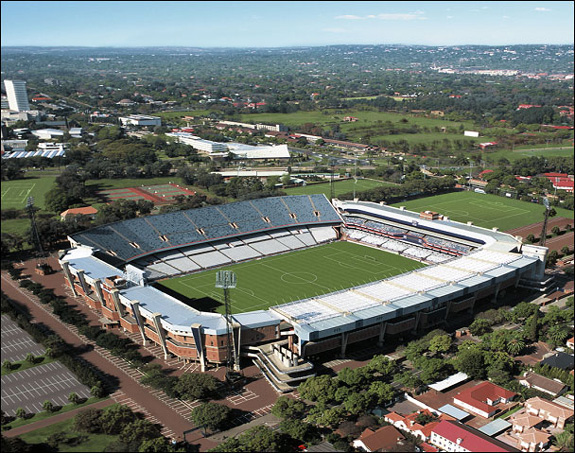
The renovations to Loftus Versfeld stadium, situated in the capital city of Pretoria started in September 2007. The majority of the work on the stadium was to the Western stand which received an upgrade and an increase in seating capacity, bringing the total number of spectators to 50,000. Home to the successful rugby team the Blue Bulls as well as too many top flight Premier Soccer League clashes, it is unlikely that Loftus Versfeld will be left gather dust once the FIFA Confederations Cup and 2010 FIFA World Cup are over.
Bloemfontein:
Free State Stadium
Architect: ACG Architects
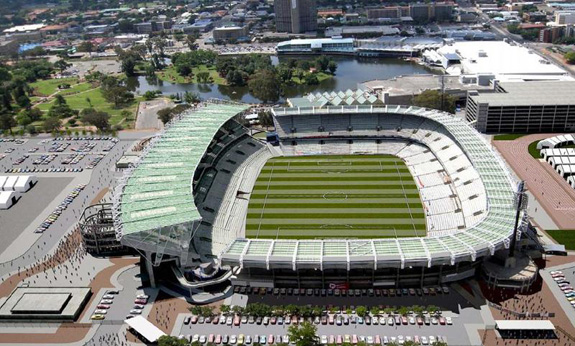
The Free State stadium, also known as Vodacom Park, is situated in the city Bloemfontein, in South Africa. The stadium was built in 1995, and was used for the first time at that year's world rugby championship. For the FIFA world cup 2010 the stadium has been upgraded and its capacity has been increased to 48.000 seats.
On behalf of ArchiTeam,
Eleni Loukidou
Alexios Vandoros (advisor)
Texts and photos:
Architects' websites
World cup 2010 official website
Related articles:
- F1 Circuit ( 28 November, 2010 )
- Indoor sports hall in Alexandroupoli ( 12 January, 2011 )
- “Sports center at the University Campus of Patras” ( 08 March, 2011 )
- Portable Extreme Park ( 03 April, 2012 )
- Serres Racing Cirquit ( 01 September, 2012 )
- Ecotourism centre - marine park facilities in island "Kelyfos" ( 17 January, 2014 )
- ALKYON. Sailing club of Rafina, Athens ( 20 August, 2014 )










